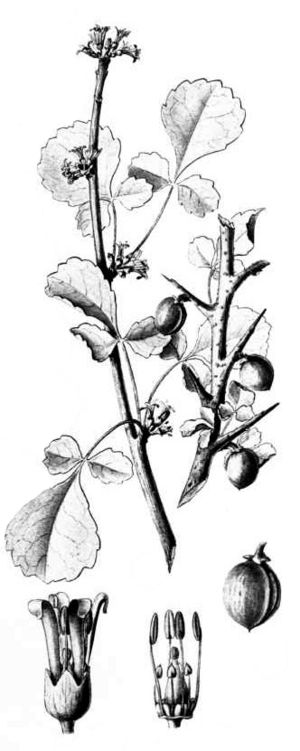African myrrh facts for kids
Quick facts for kids African myrrh |
|
|---|---|
 |
|
| Commiphora africana | |
| Scientific classification | |
| Genus: |
Commiphora
|
| Species: |
africana
|
| Synonyms | |
|
List
|
|
The Commiphora africana is a small tree often called the African myrrh. It loses its leaves every year, just like many trees in your backyard. This tree belongs to a plant family called Burseraceae. It is found across a large part of Sub-Saharan Africa, in countries like Angola, Botswana, Kenya, South Africa, and Zimbabwe. Sometimes, in sandy areas, you can find many of these trees growing close together.
Contents
What Does the African Myrrh Tree Look Like?
The African myrrh tree usually grows to about 5 meters (16 feet) tall. Its branches often have sharp points or spines at the ends. The bark is grey-green and peels off, showing a shiny surface underneath. If the bark gets damaged, it turns red and oozes a clear, sticky, sweet-smelling gum. This gum is even edible! The name 'Commiphora' actually means 'gum-bearing'.
Leaves, Flowers, and Fruits
The leaves of the African myrrh tree have three parts. There's one larger leaflet at the end and two smaller ones on the sides. Their edges are slightly bumpy. If you crush the leaves, they smell very nice, just like most trees in the Commiphora family.
The fruits are reddish and about 6–8 millimeters (0.2–0.3 inches) wide. When they are ripe, they split open. Inside, you'll find a hard, black seed. This seed is held by a special red part that looks like tiny fingers. It's almost like a jewel held in a ring!
Amazing Adaptations of the African Myrrh Tree
This tree is very sensitive to how much moisture is in the air. It starts growing new leaves as soon as it senses moist winds. This means it's one of the first trees to get its leaves when the rainy season begins. It stays green for the whole rainy period. In dry areas like the Sahel, only one other tree, the Salvadora persica, looks as fresh and green during this time.
However, the leaves only last as long as the moist air does. As soon as the rainy season ends, the leaves dry out. They turn a beautiful golden color. The Commiphora africana is smart! It quickly grows leaves, flowers, and fruits during any wet spells. Then, it goes into a resting state when the weather is dry. Even though it lives in dry places, its leaves don't look like typical drought-resistant plants.
Shepherds in the northern Sahel region watch these trees. They follow the rainfall patterns and the Commiphora africana trees as they get their leaves. This helps them find new places for their animals to eat.
Uses of the African Myrrh Tree
The African myrrh tree is very useful! Its fruits are safe to eat. People often chew its sweet, juicy roots. Camels and goats love to eat the new leaves, especially when the dry season starts.
This tree is also the favorite food plant for a beetle called Diamphidia. The larvae (baby beetles) of Diamphidia are used by some groups to make a strong arrow poison. The Commiphora africana tree is also great for making a living fence or hedge.
Traditional Medicine and Other Uses
Different parts of the tree are used to help with many health problems:
- The fruits can be used for typhoid fever and stomach issues.
- The bark is used to treat malaria.
- The resin (the sticky gum) is used for convulsions and to clean and protect wounds.
- Burnt resin can even be used to keep insects away.
The wood of the tree is soft and strong against termites. People use it to carve things for their homes, musical instruments, and other general items. An edible oil can also be taken from the tree. Some parts of the tree have strong properties that fight against fungus.
See also
 In Spanish: Bedelio de África para niños
In Spanish: Bedelio de África para niños

